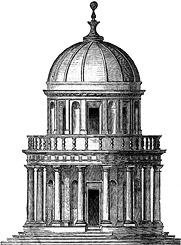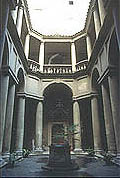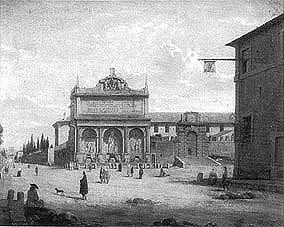Little Gems
St. Pietro in Montorio
(St. Peter on Golden Hill) (1499-1502 Andrea Bregno school). Renaissance. Rumor has it that this is the site where St. Peter was crucified.
The view of Rome from the parapet is lovely and lucky Spanish students can study in the Spanish Cultural Academy right next to the church.
It has simplicity, almost austerity, to it’s facade. But inside!
First chapel right: Sebastiano il Piombo painted a superb “Flagellation” from drawings by Michelangelo.
Fourth chapel right: Ceiling fresco by Vasari (more famous for his chronicles of Renaissance artists) who slipped his own portrait in black on the left.
Unmarked tomb of Beatrice Cenci (see: Palazzo Cenci).
Fifth chapel left: Michelangelo’s star pupil, Daniele da Volterra, painted the Baptism of Jesus.
Second chapel left: Bernini and pupil (Francesco Baratta).
|
St. Peter on Golden Hill
History Late 15C. Built on top of a medieval church by Ferdinando and Isabella of Spain, soon after they had thrown the Arabs out of Spain. 16C. Richly decorated by outstanding artists. (The Raphael and other fine paintings later disappeared into the Vatican Museums.) |
Via Garibaldi (Map D 8)
 |
Tempietto of Bramante

One of the jewels of early Renaissance architecture (Bramante 1499-1502), this perfectly circular chapel fits snugly inside the church courtyard. Notice the perfect proportions and the classic orders inspired by Ancient Roman buildings.
Medieval saints' tombs were often circular and pilgrims could easily spot them and come to pray. In Arab countries saints’ tombs are still circular, and Muslims still go and pray at them. This place is very popular today for weddings.
Fontanone of Acqua Paola
Baroque. Mended by Pope Paul V Borghese. To bring water to Trastevere, the Vatican and Via Giulia. One of the most magnificent fountains of the city because you feel so refreshed watching the enormous force of water gushing down, and because the view over Rome is spectacular from here.
You can see the fountain from most parts of Rome, it is so huge. In Summer if you’re still hot and sticky, try the ice cream parlor in a cool courtyard at the back of the fountain.
|
Fontanone of Acqua Paola
 History History98-117 AD. Trajan had water from Lake Bracciano channeled to Rome, in a mostly subterranean aqueduct. Dark Ages. Water in the aqueduct was cut off during the barbarian invasions of Rome. 1612. Pope Paul V had the aqueduct repaired, and it was named after him. 1690-98. C. Fontana pillaged marble from the Roman Forum and Forum of Nerva, and used six columns from the old St. Peter’s, to build this monumental “Mostra”, modeled on a triumphal arch. |
Via Garibaldi (Map D 8)